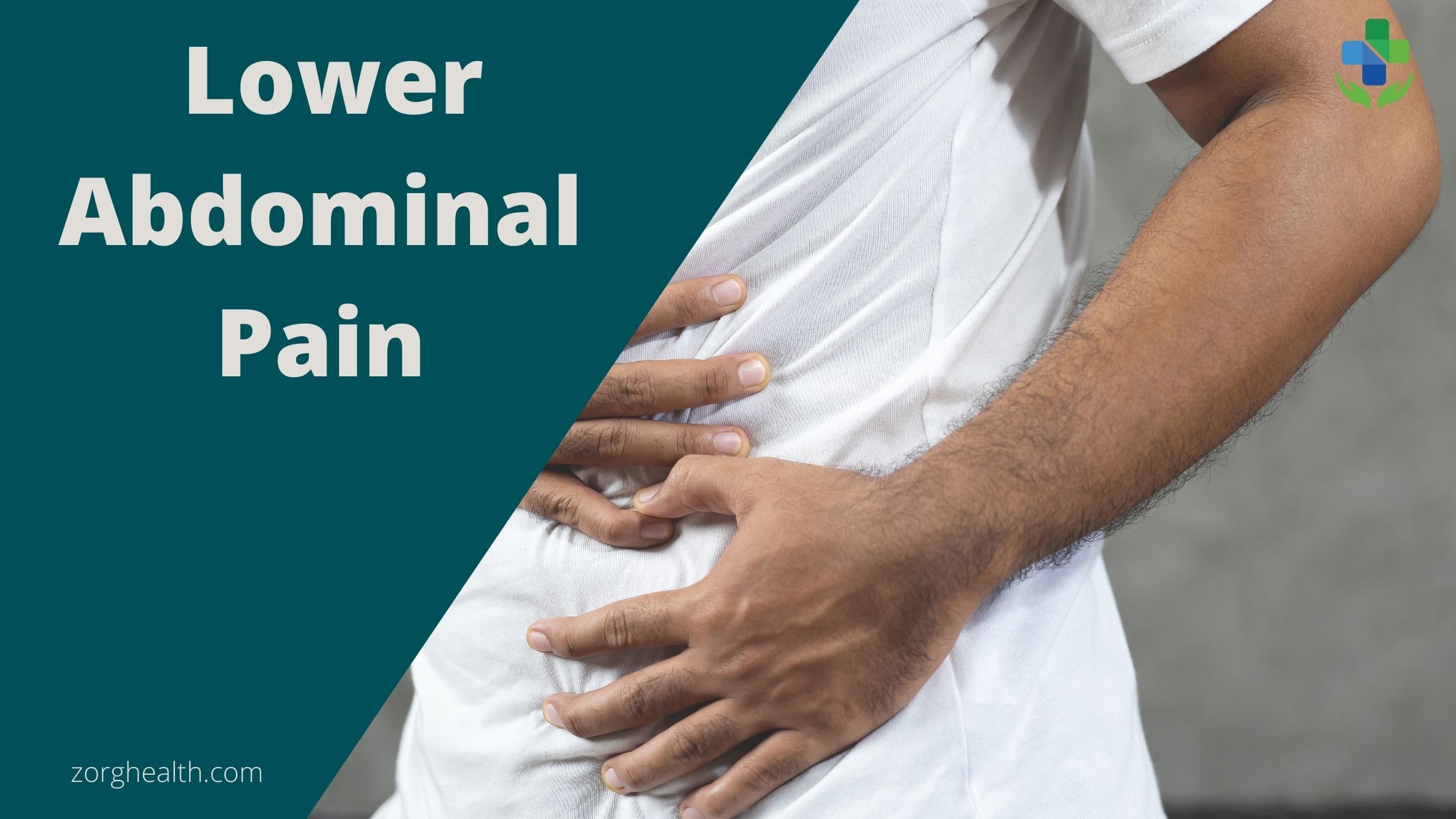What is Abdomen
Your belly is roughly referred to as your abdomen, it is the area between your rib cage and pelvic region. To facilitate easy understanding and diagnosis, your abdomen is virtually divided into 4 quadrants and further can be subdivided into even smaller 9 regions. Abdominal pain is very common, and the majority of the time it’s lower abdominal pain on the left side.

The abdomen is divided into 9 regions –
1. Right upper / Right hypochondrium– contains, liver, kidney, gallbladder, a portion of the large intestine.
2. Right middle/ Right lumbar– contains, ascending colon (large intestine), small intestine, and kidney.
3. Right lower/ Right iliac– contains, appendix, caecum, ascending colon, small intestine.
4. Upper middle/ Epigastric– contains, liver, stomach, spleen, duodenum, adrenal glands, pancreas.
5. Umbilical– contains, duodenum, small intestine, transverse colon.
6. Lower middle/ Hypogastrium – contains, bladder, sigmoid colon, small intestine, reproductive organs.
7. Left upper/ Left hypochondrium– stomach, pancreas, kidney, spleen, large intestine.
8. Left middle/ left lumbar– contains, descending colon, small intestine, kidney.
9. Left lower/ left iliac – contains, sigmoid colon, descending colon, small intestine.
These regions contain different body organs and the location of pain gives us an idea about which organ might be affected, for example, pain in the right lower abdomen is most commonly due to appendicitis.
The appendix is part of your intestine. It is a small tube-like structure with one end of its closed. it is present in the right side of your lower abdomen at the junction of the small and large intestine. Appendicitis or inflammation of the appendix is very common and leads to pain in the right lower abdomen. Appendicitis can be serious and if you feel other symptoms like nausea, fever, diarrhea, vomiting, or tenderness in the right lower abdomen then report immediately to the hospital. Sometimes its surgical removal becomes necessary. If you feel your symptoms are suggestive of appendicitis, never take medication without a prescription.
In the majority of medical centers, almost about 50 % of all emergencies are acute abdominal pains. In case you are experiencing acute pain of severe grade in the abdomen or pain due to injury, you should immediately take help and report to the emergency room.
The lower abdomen is home to the appendix, caecum, bladder, reproductive organs, and part of the large and small intestine. The most commonly abdominal pain is experienced in the lower abdomen and the commonest reasons are the following –
Reasons for lower abdominal pain on the left side –
1. Flatulence/ gas-
the gas formed as a result of digestion can get trapped in any part of the digestive tract, however, there are other factors too that can lead to excessive flatulence or bloating sensation, like- indigestion, the altered bacterial flora of the gut, eating more oily or spicy food, consuming carbonated drinks, overeating, constipation, etc.
2. Hyperacidity/indigestion–
Pain starting shortly after you eat can be due to excessive production of acid in your stomach. Although the majority of people experience pain in the stomach region it’s equally common in the lower part of the abdomen as well. Green tea and peppermint beverages are very good options to enhance digestion.
3. Diverticulitis–
Diverticula mean small outpouching of a weak area of the gut lining, they are common after 40 years of age and in the majority doesn’t cause any problem. But with time they may increase in size and become more vulnerable to tear. Their rupture can lead to diverticulitis, which means inflammation or swelling of the diverticula giving you pain in the lower abdomen. There are other symptoms of diverticulitis like fever, nausea, vomiting along pain. Report immediately to the emergency room if you notice any of that.
4. IBD/ inflammatory bowel disease–
this refers to inflammation anywhere along your digestive tract. The two conditions namely Crohn’s disease and Ulcerative colitis come under IBD. Although it’s still not known what exactly causes these conditions, they are very common and frequently present as pain in the abdomen along with other rare symptoms like, blood in stools, fever, and unexplained weight loss.
5. Hernia–
when part of the internal body organs protrudes through weak areas or gaps in your body wall. You may notice a bump or lump on a limited or localized area of your abdomen along with blinding or excruciating pain. Pain while lifting heavy weight is typical of a hernia.
6. Renal/ kidney stones–
A stone passing or stuck in your right or left ureter (the tube carrying urine from the kidney to the bladder) can give you pain in the respective side of the lower abdomen. Also, you may notice the color of your urine changing to pink or brown. You may also experience frequent urges for urination and pain or burning while urinating.
7. Celiac sprue–
Also known as celiac disease or gluten-sensitive enteropathy, is a long-term condition where your gut can’t digest gluten. Gluten is a kind of dietary protein found in large amounts in wheat and other food products. In this condition, your own immune system starts attacking the gut after consumption of gluten leading to pain, bloating, indigestion, and vitamin deficiency.
8. Constipation–
dehydration, an imbalanced diet, and starving for a longer duration can lead to constipation. Pain in the left lower abdomen can also be due to constipation. You can increase your water intake and daily activity to get some relief from constipation.
Some Particular Conditions for lower abdominal pain on the left side in Females –
1. Painful periods–
Menstrual cramps can give pain all over the abdomen, back, thigh and legs but they are more common on the left or right lower abdomen. Painful cycles are not uncommon but if it totally renders you bedridden then you should seek medical help as it can be an early sign of endometriosis.
2. Endometriosis–
In this condition, the endometrial lining (tissue that lines inside of your uterus) starts growing outside. If this happens you may experience extremely painful periods getting worse with each cycle, along with painful bowel movements and vomiting.
3. Ovarian cysts–
Ovary cysts are common observations in today’s world. Small ovarian cysts don’t cause any problem other than an irregular menstrual cycle, but as they grow in size, they can cause discomfort in the lower abdomen. Furthermore, their torsion or twisting can give you sudden very severe, and sharp pain in the lower abdomen. Ovarian torsion usually happens during reproductive age, mostly with the use of hormonal medications to induce ovulation. Very often surgery is needed to remove or untwist the cyst as twisting can compromise blood supply and affect fallopian tubes.
4. Extrauterine pregnancy–
Also known as ectopic pregnancy. In this condition, the fertilized egg or “future embryo” rather than getting implanted inside the uterus, gets implanted somewhere else before reaching the uterus. Most commonly it gets attached to the inside of fallopian tubes which in addition to severe abdominal pain can also give you discomfort during bowel and bladder movements. Ectopic pregnancy is a risky condition and one should immediately rush to the hospital in case you feel dizzy or fainting as this might be an indication of rupture of the fallopian tube.
5. Pelvic inflammatory disease (PID)–
Is the infection of female reproductive organs, uterus, fallopian tubes, or vagina. Most commonly occurs due to chlamydia or gonorrhea (sexually transmitted infections) but can also be due to other bacteria. Vaginal discharge and fever along with lower abdominal pain is classic of PID.
Lower abdominal pain on the left side in Men –
Like in females’ ovarian torsion can lead to lower abdominal pain, testicular torsion in males presents similarly. It can also lead to swelling in the scrotal area and reduced blood supply to the testis, which makes testicular torsion a medical emergency which requires surgical correction or removal.
A persisting or worsening abdominal pain with or without other alarming symptoms like fever, swelling, vomiting should be given medical attention so that a proper diagnosis can guide proper management.
